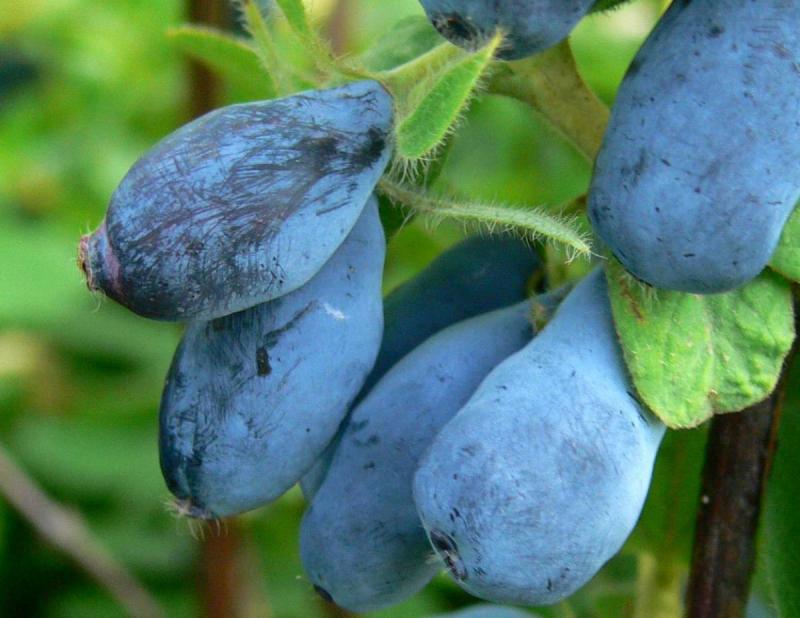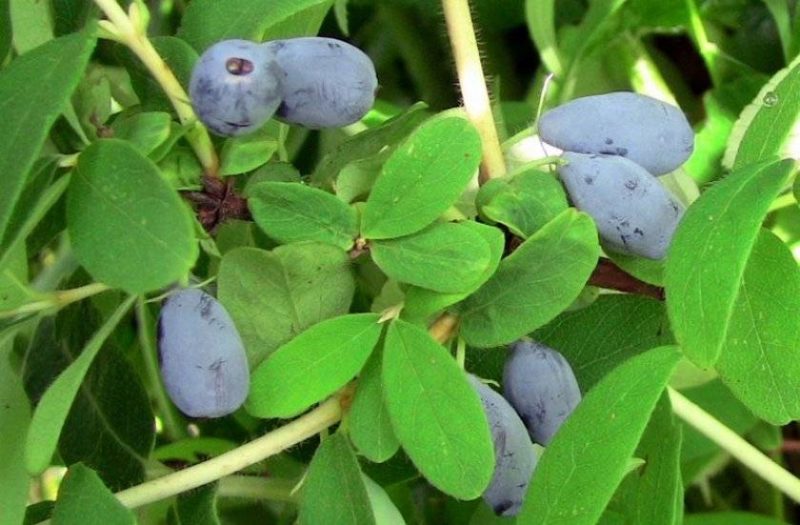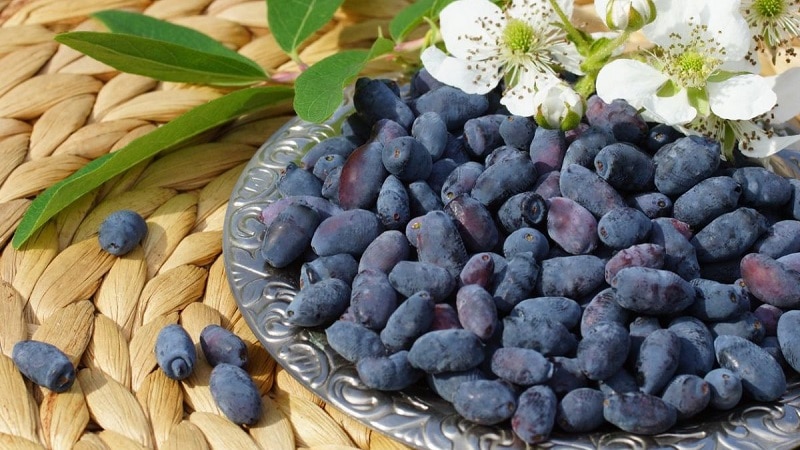Large-fruited dessert variety of honeysuckle Wojtek
Wojtek is an early-ripening edible honeysuckle native to Poland. The variety is characterized by frost resistance, large fruit and high yield. The only disadvantage noted is drought intolerance. We suggest learning in detail about the characteristics of this variety, understanding the timing and rules of planting seedlings, as well as agrotechnical requirements.
Description of the honeysuckle variety Wojtek
Wojtek - an early-ripening variety of edible honeysuckle, bred by Polish breeders. The berries contain vitamins A, B1, B2, C, as well as calcium, magnesium, potassium, sodium and phosphorus.
Consumption of honeysuckle has a positive effect on the health of the eyes, skin, hair, gastrointestinal tract, heart and nervous system, helps strengthen the immune system and remove toxins from the body, and normalizes metabolism.

Origin and development
This variety of honeysuckle was bred in Poland. Most of the work on its creation was carried out by breeders Sofia and Heronim Lukashevsky.
Characteristics, description of appearance, taste
Honeysuckle Wojtek forms vigorous (1.5 m high) spreading bushes with a raised spherical crown, reaching 2 m in diameter.
The shoots are curved, slightly pubescent, matte, of medium length, the leaves are elongated, green. During flowering (May–June), light yellow flowers appear on the bushes.
The berries are elongated, large (length 2.7-3.5 cm, diameter - 0.8 cm), weigh on average 1.16-2 g, covered with a thin violet-blue skin with a waxy coating.The pulp is tender, juicy, elastic. It is characterized by a dessert sweet taste with a slight sourness.
Features of application
Wojtek berries are consumed fresh and used for making juices, compotes, and jam.
The bushes have a decorative appearance throughout the season, so they are often used to create hedges.
Ripening period, yield and fruiting
This is an early ripening variety of honeysuckle - the fruits begin to ripen in the third decade of May. Fruiting begins 2-3 years after planting the bushes and continues for 25-30 years.
The average yield is 5 kg of berries per bush.
Resistance to diseases and pests
Honeysuckle Wojtek can be affected by powdery mildew, mottling, tubercular blight, cercospora blight, ramular blight, scale insects, leaf rollers, aphids, and finger flies.
Resistance to cold and drought
The bushes can withstand air temperature drops down to -25...-30°C, and in snowy winters - down to -35...-40°C.
Plants do not tolerate drought well. Lack of moisture negatively affects the taste of berries. At the same time, excessive watering and the close location of groundwater, leading to waterlogging of the soil, provoke rotting of the root system and death of the bushes.
Suitable regions and climate requirements
Due to its high degree of frost resistance, this honeysuckle variety is successfully cultivated not only in areas with a temperate climate, but also in the northern regions - in Siberia and the Urals.
Advantages and disadvantages of the variety

The main advantages of the variety:
- large fruit;
- low tendency to crumble;
- frost resistance;
- pleasant taste and the possibility of universal use of fruits;
- decorative appearance of bushes;
- high yield.
Among the disadvantages, only poor tolerance to drought is noted.
Difference from other varieties and hybrids
A comparison of Wojtek with other early ripening honeysuckle varieties is shown in the table.
| Variety | Average weight of berries, g | Taste | Berry color | Productivity, kg/bush |
| Wojtek | 1,16-2,0 | Sweet with sourness | Purple blue | 5 |
| Assol | 1,1-1,5 | Sweet and sour | Dark purple | 2,5 |
| Delight | 3-4 | Blue | 2,5-5 | |
| Titmouse | 0,8-1 | Black | 5-7 | |
| Long-fruited | 0,8-2,5 | Blue-violet | 1,5-3 | |
| Sweet tooth | 1,5 | Sweet | Blue | Up to 4 |
Agricultural technology
Wojtek is an unpretentious variety of honeysuckle. To get rich and quality berry harvest It is important to carry out all agrotechnical measures correctly.
Choosing a place in the garden and preparing holes
To plant this variety, choose well-lit places, protected from gusty winds and drafts, located on the plain or on a slight slope. The permissible depth of groundwater is at least 1 m.
Reference. Lack of natural light leads to reduced yields.
Preparing for landing
When purchasing seedlings, the choice is 2-year-old specimens 40 cm high with 3-4 branches and buds on the branches. There should be no defects, growths or damage on the above-ground and root parts, and according to GOST there should be no leaves on the plants.
Reference. Peeling of the bark is normal for honeysuckle.
2 weeks before planting, planting holes measuring 40x40 cm are dug in the prepared area, and the top layer of soil is thrown aside.
Soil requirements
Honeysuckle prefers loose, fertile soil with good aeration, moisture permeability and low or medium acidity.
Additional lime or dolomite flour is added to the acidified soil, and in the case of close groundwater, a drainage layer is laid at the bottom of the planting holes.
Dates, scheme and rules of planting
Wojtek honeysuckle is planted in the fall, in mid-September - mid-October, or in the spring, before the beginning of the growing season.
Planting pattern:
- Prepare a nutritious soil mixture (top layer of excavated soil, 10 kg of humus or manure, 100 g of double superphosphate, 30 g of potassium sulfate and 300 g of wood ash), pour it into the prepared holes.
- Form a hill from the soil mixture, place a seedling on it, spreading the roots along the slopes.
- Cover the plants with soil so that the root collar is buried 5-7 cm.
- Compact the soil, water the plantings at the rate of 10 liters of water for each bush.
- Mulch the soil with peat or humus.
The optimal distance between rows is 2-2.5 m, between bushes - 1.5-2 m.
Features of cultivation
On average, honeysuckle is watered 3 times per season, pouring 10 liters of water under each bush. In dry summer conditions, the frequency of watering is increased.
Fertilizers are applied 3-4 years after planting according to the following scheme:
- in spring - 10 kg of humus or rotted manure per bush;
- in autumn - 150 g of wood ash per bush;
- during the period of snow melting - watering with nitrogen fertilizers (1 tablespoon of urea per 10 liters of water);
- before flowering - foliar feeding with complex fertilizers.
They begin to prune bushes when they are 4-5 years old. The procedure is carried out in the spring, at the end of March - beginning of April, or in the fall. When formative pruning, you cannot remove the tops of the shoots, since most of the inflorescences form on them.
Pollinators
To obtain a rich harvest, pollinating varieties are planted near the Voytek bushes: blue bird, Karina, Blue spindle.
Without cross-pollination, the berries on the bushes do not set at all or there are few of them, and they form small and sour.
Disease and pest control
Diseases and pests that can affect Wojtek honeysuckle are described in the table.
| Disease/pest | Signs | Treatment/prevention |
| Mottling | The leaves become pale green, whitish streaks and yellow spots appear on them. | Parts of plants affected by the disease are cut from the bushes and burned. |
| Powdery mildew | A cobweb-like white coating appears on the leaves and shoots. | Infected areas are removed, and the bushes are treated with sulfur-containing preparations. |
| Tuberculariosis | Dark spots appear on the foliage, and red-brown bumps appear on the shoots. | To prevent the disease, all affected areas are removed and the bushes are sprayed with Bordeaux mixture. |
| Cercospora | Dark green spots appear on the bushes; over time, all damaged areas become brown or light gray. | The bushes are regularly pruned and thinned, and the plants are fed with mineral fertilizers. |
| Ramulariasis | Individual fragments of leaves dry out and acquire a dark brown color. | All affected areas are removed, and the bushes are treated with Bordeaux mixture. |
| Shields | Insects suck sap from plants. | Plantings are treated with insecticidal preparations (Calypso, Aktara) or a soap-alcohol solution. |
| Leafrollers | Pests feed on leaves and shoots of honeysuckle. | Spraying bushes with insecticides (for example, Aktara). |
| Aphid | Insects feed on the sap of leaves and shoots. | The bushes are treated with a soap and tobacco solution. |
| fingerwings | They eat berries. | The bushes are sprayed with Inta-Vir. |
Preparing for winter
Due to their high degree of frost resistance, Wojtek honeysuckle bushes do not require pre-winter preparation or additional shelter.
Reproduction
Most often, honeysuckle is propagated vegetatively:
- Green cuttings. From the second half of May to mid-June, the still green but already brittle branches are cut into pieces 8-13 cm long so that each has 3-4 buds. The upper cut is made at a right angle 2 cm above the internode, the lower cut at an angle of 45°. The cuttings are soaked for a day in a solution of a growth stimulant (for example, “Kornevine”), then placed in a container with water or a damp substrate for rooting.
- Lignified cuttings. One-year-old brown shoots with a diameter of 6-9 mm are cut into pieces so that each has 2-5 internodes, wrapped in a damp cloth and buried in the sand. In the spring, the cuttings are planted in the substrate, leaving 1 bud above the surface of the ground.
- Horizontal layering. Before sap flow begins, 3-4 one-year-old shoots are selected from the lower part of the bush, tilted to the ground, secured with wire and sprinkled with soil. The cuttings are regularly watered and hilled, and after rooting they are separated from the parent bush and planted in a permanent place.
- Dividing the bush. An adult (3-6 years old) bush with 6-9 skeletal branches is dug up and divided into parts so that each has 2-3 shoots and rhizomes. The sections are sprinkled with crushed coal or ash, and the sections are planted in a permanent place.
Honeysuckle is also propagated generatively. To do this, during harvesting, large fruits are selected, crushed, and seeds selected. The seed is washed, dried and sown immediately or before winter.
Important! In the case of seed propagation, the varietal characteristics of the plant may be lost.
Difficulties in growing
When growing honeysuckle Wojtek you may encounter the following difficulties:
- low yield or complete absence of berries due to the lack of pollinating varieties on the site;
- the formation of small fruits, the appearance of strong acid in their taste when growing honeysuckle in an area where there is not enough sunlight;
- the appearance of a white powdery coating on the bushes - a sign of powdery mildew, which most often develops as a result of waterlogging.
Harvesting

The harvest begins a week after the berries acquire a rich purple-blue color. In order not to lose the fruits during harvesting, a film or cloth is first spread under the bushes.
The collected berries are carefully placed in a shallow container in 1 layer. Fresh fruits are stored in the refrigerator for 2-3 days.
Tips and reviews from experienced gardeners
Gardeners recommend:
- Do not cut skeletal branches to the very base - the buds that restore the crown are located in the places where they branch.
- Perform pruning only on the lower tier - these shoots do not bear fruit and interfere with caring for the bushes.
They respond positively to the Wojtek variety.
Nina, Moscow region: “I really like this variety of honeysuckle. Unpretentious, forms beautiful bushes, produces a lot of tasty berries. My grandchildren love to eat them fresh, and I make jam from the remaining harvest.”
Alexandra, Bryansk: “For me, there are no flaws in Wojtek honeysuckle. Someone mentions the need for watering, but in my opinion it’s not difficult to pour a few buckets of water under the bushes. The variety is frost-resistant, the yield is excellent, the berries are large and tasty. I recommend".
Conclusion
Wojtek is an early ripening variety of edible honeysuckle. Among its advantages, especially noteworthy are a high degree of frost resistance, large fruit, sweet and slightly sour taste of berries, high yield and a long period of bush productivity.
The only disadvantages include poor tolerance to drought and the need for regular watering.